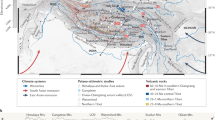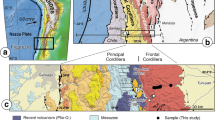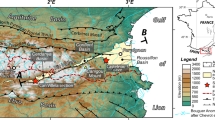Abstract
The northwest Himalaya shows strongly contrasting relief. Deeply incised mountain ranges that are characterized by extremely rapid exhumation1,2,3 and some of the highest peaks in the world are in contrast with high-elevation, low-relief areas such as the Deosai plateau in northern Pakistan, which lies at an altitude of 4,000 m. The origin and evolution of such plateau regions at the convergence of the most active continental collision in the world remain elusive. Here we report low-temperature thermochronology data from the Deosai plateau and use thermal history modelling to show that the plateau has undergone continuous slow denudation at rates below 250 m Myr−1 for the past 35 Myr at least. This finding suggests tectonic and morphologic stability of the plateau since at least Eocene times, only 15–20 Myr after the onset of the India–Asia collision. Our work contradicts the hypothesis that widespread low-relief surfaces in the northwest Himalaya result from efficient kilometre-scale glacial erosion during Quaternary times4. We show that similarly stable surfaces exist throughout the entire northwest Himalaya and share common morphologic characteristics and denudation histories, which are comparable to those of the western Tibetan plateau. Our results suggest that these surfaces are preserved remnants of an Eocene southwestern Tibetan plateau that was more extensive than today.
This is a preview of subscription content, access via your institution
Access options
Subscribe to this journal
Receive 12 print issues and online access
$259.00 per year
only $21.58 per issue
Buy this article
- Purchase on Springer Link
- Instant access to full article PDF
Prices may be subject to local taxes which are calculated during checkout




Similar content being viewed by others
References
Burbank, D. W. et al. Bedrock incision, rock uplift and threshold hillslopes in the northwestern Himalayas. Nature 379, 505–510 (1996).
Zeitler, P. K. et al. Crustal reworking at Nanga Parbat, Pakistan: Metamorphic consequences of thermal–mechanical coupling facilitated by erosion. Tectonics 20, 712–728 (2001).
Schneider, D. A., Zeitler, P. K., Kidd, W. S. F. & Edwards, M. A. Geochronologic constraints on the tectonic evolution and exhumation of Nanga Parbat, western Himalaya syntaxis, revisited. J. Geol. 109, 563–584 (2001).
Brozoviç, N., Burbank, D. W. & Meigs, A. J. Climatic limits on landscape development in the northwestern Himalaya. Science 276, 571–574 (1997).
Zeitler, P. K. et al. Erosion, Himalayan geodynamics, and the geomorphology of metamorphism. GSA Today 11, 4–9 (2001).
Foster, D. A., Gleadow, A. J. W. & Mortimer, G. Rapid Pliocene exhumation in the Karakoram (Pakistan), revealed by fission-track thermochronology of the K2 gneiss. Geology 22, 19–22 (1994).
Mahéo, G., Guillot, S., Blichert-Toft, J., Rolland, Y. & Pêcher, A. A slab breakoff model for the Neogene thermal evolution of South Karakorum and South Tibet. Earth Planet. Sci. Lett. 195, 45–58 (2002).
Zeitler, P. K. Cooling history of the NW Himalaya, Pakistan. Tectonics 4, 127–151 (1985).
Yin, A. & Harrison, T. M. Geologic Evolution of the Himalayan–Tibetan Orogen. Annu. Rev. Earth Planet. Sci. 28, 211–280 (2000).
Garzanti, E., Baud, E. & Mascle, G. Sedimentary record of the northward flight of India and its collision with Eurasia (Ladakh Himalaya, India). Geodyn. Acta 1, 297–312 (1987).
de Sigoyer, J. et al. Dating the Indian continental subduction and collisional thickening in the northwest Himalaya: Multichronology of the Tso Morari eclogites. Geology 28, 487–490 (2000).
Guillot, S. et al. Reconstructing the total shortening history of the NW Himalaya. Geochem. Geophys. Geosyst. 4, 1064 (2003).
Treloar, P. J., Williams, M. P. & Coward, M. P. Metamorphism and crustal stacking in the North Indian Plate, North Pakistan. Tectonophysics 165, 167–184 (1989).
Tapponnier, P. et al. Oblique stepwise rise and growth of the Tibet Plateau. Science 294, 1671–1677 (2001).
Gansser, A. Geology of the Himalayas (Wiley, 1964).
Reiners, P. W. & Ehlers, T. A. (eds) Low-Temperature Thermochronology: Techniques, Interpretations, and Applications (Mineralogical Society of America/Geochemical Society, 2005).
Braun, J., van der Beek, P. & Batt, G. Quantitative Thermochronology: Numerical Methods for the Interpretation of Thermochronological Data (Cambridge University Press, 2006).
Ketcham, R. A. in Low-Temperature Thermochronology: Techniques, Interpretations, and Applications (eds Reiners, P. W. & Ehlers, T. A.) 275–314 (Mineralogical Society of America/Geochemical Society, 2005).
Seong, Y. B. et al. Quaternary glacial history of the Central Karakoram. Quat. Sci. Rev. 26, 3384–3405 (2007).
Shroder, J. F. Jr, Owen, L. & Derbyshire, E. in Himalaya to the Sea: Geology, Geomorphology and the Quaternary (ed. Shroder, J. F. Jr) 132–158 (Routledge, 1993).
Leland, J., Reid, M. R., Burbank, D. W., Finkel, R. & Caffee, M. Incision and differential bedrock uplift along the Indus River near Nanga Parbat, Pakistan Himalaya, from 10Be and 26Al exposure age dating of bedrock straths. Earth Planet. Sci. Lett. 154, 93–107 (1998).
Najman, Y. The detrital record of orogenesis: A review of approaches and techniques used in the Himalayan sedimentary basins. Earth-Sci. Rev. 74, 1–72 (2006).
Kumar, R., Lal, N., Singh, S. & Jain, A. K. Cooling and exhumation of the Trans-Himalayan Ladakh batholith as constrained by fission track apatite and zircon ages. Curr. Sci. 92, 490–496 (2007).
Kirstein, L. A., Foeken, J. P. T., van der Beek, P. A., Stuart, F. M. & Phillips, R. J. Cenozoic unroofing history of the Ladakh Batholith, western Himalaya, constrained by thermochronology and numerical modeling. J. Geol. Soc. London (2009, in the press).
Schlup, M., Carter, A., Cosca, M. & Steck, A. Exhumation history of eastern Ladakh revealed by 40Ar/39Ar and fission-track ages: The Indus River—Tso Morari transect, NW Himalaya. J. Geol. Soc. Lond. 160, 385–399 (2003).
Rowley, D. B. & Currie, B. S. Palaeo-altimetry of the late Eocene to Miocene Lunpola basin, central Tibet. Nature 439, 677–681 (2006).
DeCelles, P. G. et al. High and dry in central Tibet during the Late Oligocene. Earth Planet. Sci. Lett. 253, 389–401 (2007).
Wang, C. et al. Constraints on the early uplift history of the Tibetan Plateau. Proc. Natl Acad. Sci. 4987–4992 (2008).
Sinclair, H. D. & Jaffey, N. Sedimentology of the Indus Group, Ladakh, northern India: Implications for the timing of initiation of the palaeo-Indus River. J. Geol. Soc. Lond. 158, 151–162 (2001).
Valli, F. et al. Twenty million years of continuous deformation along the Karakorum fault, western Tibet: A thermochronological analysis. Tectonics 26, TC4004 (2007).
Farley, K. A. in Noble Gases in Geochemistry and Cosmochemistry (eds Porcelli, D. P., Ballentine, C. J. & Wieler, R.) 819–843 (Mineralogical Society of America/Geochemical Society, 2002).
Ketcham, R. A., Donelick, R. A. & Carlson, W. D. Variability of apatite fission-track annealing kinetics: III. Extrapolation to geological time scales. Am. Mineral. 84, 1235–1255 (1999).
Farley, K. A. Helium diffusion from apatite: General behavior as illustrated by Durango fluorapatite. J. Geophys. Res. 105, 2903–2914 (2000).
Reiners, P. W., Spell, T. L., Nicolescu, S. & Zanetti, K. A. Zircon (U–Th)/He thermochronometry: He diffusion and comparisons with 40Ar/39Ar dating. Geochim. Cosmochim. Acta 68, 1857–1887 (2004).
Acknowledgements
The Geological Survey of Pakistan and the French Embassy in Pakistan provided support during field work. (U–Th)/He thermochronology was supported by the University of Arizona in the framework of the 2007 He-Dating Workshop in Arizona. Partial support for this work was also provided by the French Agence Nationale de la Recherche. We thank Andrew Meigs and Albrecht Steck for constructive comments.
Author information
Authors and Affiliations
Contributions
P.v.d.B., J.V.M., S.G., A.P., and M.L. conducted fieldwork; J.V.M. processed samples and conducted thermochronological (AFT and (U–Th)/He) and morphometric analyses; P.W.R. and S.N. conducted and supervised (U–Th)/He analyses; P.v.d.B., S.G., A.P. and J.V.M. designed the study and wrote the paper; all authors discussed and commented on the manuscript.
Corresponding author
Supplementary information
Supplementary Tables S1–S4
Supplementary Information (PDF 240 kb)
Rights and permissions
About this article
Cite this article
van der Beek, P., Van Melle, J., Guillot, S. et al. Eocene Tibetan plateau remnants preserved in the northwest Himalaya. Nature Geosci 2, 364–368 (2009). https://doi.org/10.1038/ngeo503
Received:
Accepted:
Published:
Issue Date:
DOI: https://doi.org/10.1038/ngeo503
This article is cited by
-
Geochemical characteristics of Sr isotopes in the LS33 drill core from the Qiongdongnan Basin, South China Sea, and their response to the uplift of the Tibetan Plateau
Acta Oceanologica Sinica (2023)
-
Quantitative analysis of planation surfaces of the upper Yangtze River in the Sichuan-Yunnan Region, Southwest China
Frontiers of Earth Science (2019)
-
Making a mountain out of a plateau
Nature (2017)
-
The Qingzang movement: The major uplift of the Qinghai-Tibetan Plateau
Science China Earth Sciences (2015)
-
TTG-type plutonic rocks formed in a modern arc batholith by hydrous fractionation in the lower arc crust
Contributions to Mineralogy and Petrology (2013)



